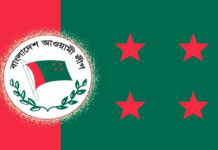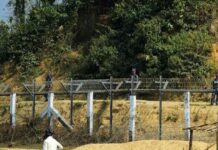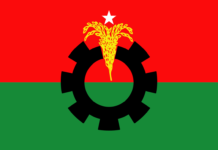Dhaka: Amid the turmoil in Bangladesh over the death sentence given to a top Islamic leader, Shahbagh Square here has become the focal point where three young women – known as ‘Agni Kanyas’ – with their forceful and rhythmic sloganeering emerged as the voice of the popular movement.
An unassuming 20-year-old Barsha Shrabanti Akhtar, who draws inspiration from West Bengal chief minister Mamata Banerjee, leads the trio as she campaigns from 8 in the morning till 2 in the night, sloganeering in her spirited voice as Shahbagh Square has taken the shape of Tahrir Square where the Egyptian Revolution evolved in 2011.
“We all look up to Mamata Didi (Mamata Banerjee) as a firebrand leader in West Bengal. I may not agree to all her ways — like the stand on water sharing, but I admire her fighting spirit and want to emulate her,” Barsha said.
The Islamia College student did not know she had it in her to draw the crowd till the revolution happened but now after realising her true potential she wants to become a political leader.
“I really love politics. The country is going through a difficult phase. We need powerful leaders… Hope I can become one in future,” she added.
Well-known television journalist Munni Saha said the ‘Agni Kanyas’ (firebrand daughters) have amazing power to pull the crowd.
“Their images with the Bangladeshi National flag around the forehead attract the crowd on TV. The viewers see a reflection of their own angst and aspirations in them,” the Dhaka-based journalist said.
Hotel housekeeping staff Abul Kalam Azad spends at least two hours a day at the Projonmo Chottor joining the ‘Agni Kanyas’ after his work hours. Azad has also encouraged his 14-year-old daughter Brishti to join the demonstration after school hours.
“The youngsters have only read and heard about the Liberation war (of 1971). Now is their opportunity to participate in one. It is they who must determine what Bangladesh will be in future,” Azad summed up.
The protests have been going on since February 5, after a tribunal gave life sentence to a war criminal of 1971 and Jamaat-e-Islami leader Abdul Quader Mollah.
Spontaneous agitation began, demanding capital punishment for the war criminals of 1971 and quickly spread via different social networks and blogs.
The square, which the country refers to as the Projonmo Chottor (square for revolution), has drawn people from all walks of life, fuelled by a common cause to determine the future of Bangladesh.
Most of the protesters are young and born after the 1971 Liberation War in which Razakars or pro-Pakistani militia are accused of loot and rape. Among the accused is Jamaat leader Mollah, whose supporters have unleashed violence across the country to counter the protests at Shahbagh, leading to over 60 deaths so far.
“This movement will make or break Bangladesh. An overwhelming majority of Bangladeshis want the country to be secular like India. But Islamist parties are opposing it.
“Our campaign is as much for death penalty for Razakars as it is for a ban on fundamentalist parties like the Jamaat from contesting elections,” Barsha said, shouting ‘Phansi, phansi, phansi chai! Razakar der phansi chai!’ (We want capital punishment for Razakars — pro-Pakistani militia who are accused of loot and rape).
The country’s main opposition party, Begum Khaleda Zia-led Bangladeshi Nationalist Party, has however queered the pitch by extending unequivocal support to the Jamaat.
The party in power — Sheikh Hasina’s Awami League — has been forced to engage with the revolutionaries at Shahbagh following popular support of the masses. Known for her secular credentials, Hasina is now battling the divisive forces and trying to prevent its Talibanisation.
“India helped Bangladesh in its Liberation War. But for India, Bangladesh may well have remained East Pakistan. We want India to support us again on this second liberation struggle against fundamentalist forces,” said Shiuli Akhter, one of the several thousand protesters.
Source: Zee News










No wonder the country is in a mess. With ill-informed and ignorent youths like Shiuli Akhter who thinks “But for India, Bangladesh may well have remained East Pakistan”, what else can one expect? As a freedom fighter I can confirm that while India’s humanitarian help in accommodating thousands of refusees,mostly Hindus, was much appreciated, it was the Mukti Bahini and the people of Bangladesh who fought, sacrificed their lives to gain their independence. India formally entered the conflict when the war was nearly won by the people of Bangladesh and at a time convenient to India and not a day earlier.
Instead of wasting their time occupying Shahbag area causing immense problem for the people of Dhaka in persuit of their day to day life, I advise them go home and learn what actually happened in 1971.